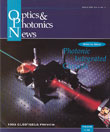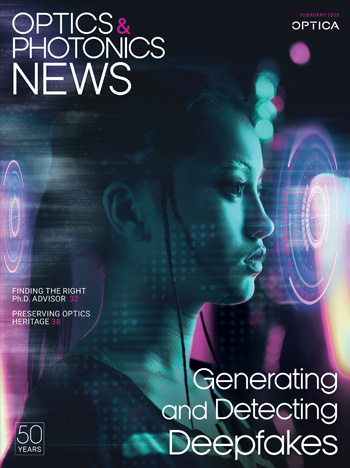
March 1993 Issue
- Photonic Integrated Circuits for High-Power Coherent Diode Lasers
- Semiconductor Laser Amplifier Gate Switch Arrays: Devices for the Broadband Transport Network
- Photonic Integrated Circuits for the Access Network
- Integrated DFB Laser-electro-absorption Modulator Using Selective-area MOVPE
- Widely Tunable Vertical Coupler Filtered Laser
- Monolithic Integrated Multi-wavelength DFB Laser Arrays and Star Couplers for WDM Lightwave Systems
- Fabrication of Optical Splitters and Wavelength Routers Using InP-Technology
- Browse all Issues
Feature Articles
Photonic Integrated Circuits for High-Power Coherent Diode Lasers
For the first time, semiconductor lasers have demonstrated single spectral and spatial mode outputs in excess of 2 W cw. This milestone demonstration opens up a number of new markets that have traditionally been inaccessible for laser diodes, including space communication, high power frequency doubling, materials processing, and high resolution printing. As a measure of the significance of the 2 W cw coherent semiconductor laser, we note that the brightness of the laser diode at an output power of 2 W cw and a wavelength of 1 μm corresponds to the same brightness of a CO2 laser operating at an output power of 200 W cw at a wavelength of approximately 10 μm. At such a high brightness, the laser diode can be incoherently coupled via brightness-conserving optics to meet the requirements of present lasers used in machining and welding systems.
by David F. WelchSemiconductor Laser Amplifier Gate Switch Arrays: Devices for the Broadband Transport Network
Current usage of optical transmission is limited to point-to-point transmission, with the involvement of photonic devices essentially limited to the source (laser) and detector. The drastic increase in transmission capacity required by introduction of broadband services offering speech, data, and video in an integrated digital format has led to a growing interest in photonic networks, where photonic devices also perform routing and switching operations. Photonic space switch arrays have long been recognized as key elements in such photonic networks, due to their capability to route optical signals essentially independently of bit rate and coding format ("network transparency").
by Mats Gustavsson, Mats Janson, and Lars ThylenPhotonic Integrated Circuits for the Access Network
Photonic Integrated Circuits (PICs) are single chips of semiconductor onto which a number of optical and optoelectronic subcomponents are monolithically integrated to form, for instance, an optical terminal circuit. The motivation is the same as was the case at the dawn of the Si circuit age: the promise of reduced cost and size, increased component reliability, and more practical solutions to systems' requirements compared to implementations based on discrete devices. There is a very wide range of potential applications for PICs, including many within telecommunications, such as optical access terminals, LANs, trunk links, and intraexchange links. Military/avionic applications are in networking, EW/ECM (Electronic Warfare/Electronic Counter Measures) and sensing.
by Peter J. Williams, Paul M. Charles, and Andrew C. CarterIntegrated DFB Laser-electro-absorption Modulator Using Selective-area MOVPE
High-modulation-speed, spectrum-stabilized transmitters operating at 1.55 μm wavelength range are key components in the rapidly developing high-capacity long distance optical fiber communication systems. The latter spectral requirement is closely related to the time-broadening an optical pulse suffers as it propagates through dispersive fibers, and this pulse broadening seriously limits the bit-rate and the maximum transmission distance. External optical modulators have been studied intensively to overcome this problem, to avoid the large wavelength fluctuation (called chirp) that occurs with conventional directly modulated laser diodes.
by Masahiro AokiWidely Tunable Vertical Coupler Filtered Laser
Fortunately, continued advances in photonic integration technology have made possible the fabrication of novel wavelength filters, such as the grating assisted vertical coupler, that are inherently more broadly tunable than Bragg reflectors. By further employing advanced photonic circuit fabrication techniques, this filter has been integrated with a gain section to build a monolithic laser with a tuning range exceeding 500 Å.
by R.C. Alferness and U. KorenMonolithic Integrated Multi-wavelength DFB Laser Arrays and Star Couplers for WDM Lightwave Systems
Traditionally, the increased transmission bandwidth has been accomplished by time-division-multiplexing through the increase in the transmission speed. This is because the cost in transmission per bit per kilometer of fiber has been decreasing continuously up to a speed of 2.5 Gb/sec. As a result, the transmission capacity has been about doubling every year from 1980 through 1988. Recently, commercial systems at rates of 1.2 and 1.7 Gb/sec have been installed, and 2.5 Gb/ sec systems are planned for new installations. For systems at higher bit rates beyond 2.5 Gb/sec, the fiber dispersion sets a limit on the transmission distances and their deployment relies on the availability of cost-effective high speed electronics.
by Chung-En Zah and Tien Pei LeeFabrication of Optical Splitters and Wavelength Routers Using InP-Technology
Photons are the preferred carrier for data transmission due to their high bandwidth and low attenuation in optical fibers. So far, they have been used only in point-to-point transmission systems. The throughput capacity of such a system is limited by transmitter/receiver bandwidth. The electronic bottleneck is even more severe in multiple access networks due to the low switching speeds achievable by electronic circuits. Optical wavelength division multiplexing (WDM) can circumvent some of the limitations imposed by electronics.
by M. Zirngibl
![Illustration of a synapse in the brain. [Getty Images]](https://opnmedia.blob.core.windows.net/$web/opn/media/images/articles/2025/0425/departments/202504-cover-web.jpg?ext=.jpg)
![Fiber draped around a hand, demonstrating its flexibility. [Photo by Z. Wang and L. Wei]](https://opnmedia.blob.core.windows.net/$web/opn/media/images/articles/2025/0325/departments/202503-cover-web.jpg?ext=.jpg)
